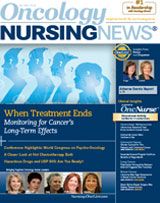Supporting Adolescents and Young Adults With Cancer From Diagnosis Through Survivorship
Adolescents and young adults (AYAs) with cancer diagnosed between the ages of 15 and 39 are a unique group of patients with distinct cancer epidemiology and developmental characteristics.
Anne Kirchhoff, PhD, MPH
Assistant Professor of Pediatrics,
Investigator
Huntsman Cancer Institute
University of Utah Health Care
Salt Lake City, UT
Adolescents and young adults (AYAs) with cancer diagnosed between the ages of 15 and 39 are a unique group of patients with distinct cancer epidemiology and developmental characteristics. Nearly 70,000 AYAs are diagnosed with cancer each year in the United States and cancer is the leading cause of disease- related death in this group.1
AYA cancer patients are often considered to be in “no-man’s-land” for their oncology care as they may not fit a pediatric or adult oncology profile.2 When cancer occurs during this time of life, it can interrupt education, work, marriage, and parenthood.3,4 Furthermore, young adults in their 20s are uninsured at higher levels than older adults, meaning that access to timely diagnosis and follow-up care is challenging.2
Due to AYAs’ unique characteristics, there is a growing effort to address their oncology needs. In 2005, the Adolescent and Young Adult Oncology Progress Review Group, a partnership between the National Cancer Institute (NCI) and LIVESTRONG Foundation, was developed to evaluate the clinical and research needs of this unique oncology population.2 In 2012, the NCI convened experts in AYA oncology to review the evidence, identify gaps, and provide research priorities on AYA oncology research.1
Utah will soon launch the Huntsman Intermountain- Adolescent and Young Adult (HI-AYA) program R. Lor Randall, MD, FACS, and Carolyn Reynolds, MS, APRN, are Co-Directors of HI-AYA, which is a Huntsman-Intermountain Cancer Care Program Best Practices Task Force. Our goal is to develop patient navigation for AYAs with cancer throughout Utah. Funding support includes The L.B. & Olive S. Young Endowed Chair for Cancer Research and a Utah Department of Health grant.
The majority of AYA patients with cancer in Utah are never seen by a pediatric oncologist.5 Because we know AYAs are less likely to be enrolled in a clinical trial, consultation from or treatment at a pediatric or adult cancer center may provide opportunities for this patient group.1,2
Holly Spraker-Perlman, MD, MS, an assistant professor of Pediatrics at the University of Utah, is using Utah Cancer Registry data to ascertain what percentage of AYA patients are seen at a cancer center in Utah and to determine what percentage of these patients go on clinical trials. She will use this information as a platform to assess the need for a specialized AYA program in Utah. Dr Spraker-Perlman is also working to develop a survey to understand how primary care providers refer AYAs with suspected cancer to an oncology specialist.
Yelena Wu, PhD, is an investigator at Huntsman Cancer Institute who does research on healthy lifestyle behaviors (exercise, healthy diet). In the Cancer Survivor Health Study (CASH), she conducted focus groups and interviews with AYA cancer survivors to understand barriers to exercise and a healthy diet. Her research team found that there are several modifiable factors (eg, motivation, mood, knowledge, and skills) that could improve adherence to recommended behaviors for this population.
CASH also included survivors’ supporters (ie, family members, spouses, and friends). Survivors’ supporters were less informed about certain healthy lifestyle behaviors, meaning that supporters should be educated about recommendations for healthy lifestyle behaviors to support AYAs’ adoption of and adherence to exercise and a healthy diet.
Dr Wu also leads a study of the feasibility and acceptability of a smartphone reminder application to promote AYAs’ adherence to oral medications. Oral medications have an expanding role in cancer treatment, which places great responsibility on the patient. Nonadherence to oral medications is prevalent among AYAs and may impact their quality of life in addition to their survival. As such, implementing medication adherence interventions to support this distinct group of patients is crucial.
Through the research programs of Drs Spraker-Perlman and Wu, as well as the development of the HI-AYA initiative, Utah hopes to transform the care and treatment of AYAs with cancer.
References
1. Nass SJ, Beaupin LK, Demark-Wahnefried W, et al. Identifying and addressing the needs of adolescents and young adults with cancer: summary of an Institute of Medicine Workshop (2015). Oncologist. 2015;20(2):186-195.
2. Adolescent and Young Adult Oncology Progress Review Group. Closing the Gap: Research and Care Imperatives for Adolescents and Young Adults with Cancer. US Department of Health and Human Services, National Institutes of Health, National Cancer Institute, LIVESTRONG Young Adult Alliance; 2006.
3. Kirchhoff AC, Spraker-Perlman H, McFadden M, et al. Sociodemographic disparities in quality of life for adolescent and young adult cancer survivors. J Adolesc Young Adult Oncol. 2014;3(2):66-74.
4. Parsons HM, Harlan LC, Lynch CF, et al. Impact of cancer on work and education among adolescent and young adult cancer survivors. J Clin Oncol. 2012;30(19):2393-2400.
5. Albritton KH, Wiggins CH, Nelson HE, Weeks JC. Site of oncologic specialty care for older adolescents in Utah. J Clin Oncol. 2007;25(29):4616-4621.

Innovative Program Reduces Nurse Turnover and Fosters Development
Published: September 12th 2024 | Updated: September 12th 2024The US Oncology Network (The Network) has developed one of the most comprehensive programs in the nation to support the professional development and retention of new oncology nurses.


